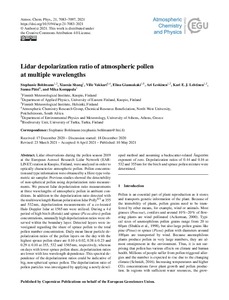Lidar depolarization ratio of atmospheric pollen at multiple wavelengths
Vakkari Ville; Lehtinen Kari EJ; Shang Xiaoxia; Komppula Mika; Bohlmann Stephanie; Leskinen Ari; Giannakaki Elina; Pätsi Sanna
Lidar depolarization ratio of atmospheric pollen at multiple wavelengths
Vakkari Ville
Lehtinen Kari EJ
Shang Xiaoxia
Komppula Mika
Bohlmann Stephanie
Leskinen Ari
Giannakaki Elina
Pätsi Sanna
COPERNICUS GESELLSCHAFT MBH
Julkaisun pysyvä osoite on:
https://urn.fi/URN:NBN:fi-fe2021093048318
https://urn.fi/URN:NBN:fi-fe2021093048318
Tiivistelmä
Lidar observations during the pollen season 2019 at the European Aerosol Research Lidar Network (EAR-LINET) station in Kuopio, Finland, were analyzed in order to optically characterize atmospheric pollen. Pollen concentration and type information were obtained by a Hirst-type volumetric air sampler. Previous studies showed the detectability of non-spherical pollen using depolarization ratio measurements. We present lidar depolarization ratio measurements at three wavelengths of atmospheric pollen in ambient conditions. In addition to the depolarization ratio detected with the multiwavelength Raman polarization lidar Polly(XT) at 355 and 532 nm, depolarization measurements of a co-located Halo Doppler lidar at 1565 nm were utilized. During a 4 d period of high birch (Betula) and spruce (Picea abies) pollen concentrations, unusually high depolarization ratios were observed within the boundary layer. Detected layers were investigated regarding the share of spruce pollen to the total pollen number concentration. Daily mean linear particle depolarization ratios of the pollen layers on the day with the highest spruce pollen share are 0.10 +/- 0.02, 0.38 +/- 0.23 and 0.29 +/- 0.10 at 355, 532 and 1565 nm, respectively, whereas on days with lower spruce pollen share, depolarization ratios are lower with less wavelength dependence. This spectral dependence of the depolarization ratios could be indicative of big, non-spherical spruce pollen. The depolarization ratio of pollen particles was investigated by applying a newly developed method and assuming a backscatter-related Angstrom exponent of zero. Depolarization ratios of 0.44 and 0.16 at 532 and 355 nm for the birch and spruce pollen mixture were determined.
Kokoelmat
- Rinnakkaistallenteet [19240]
